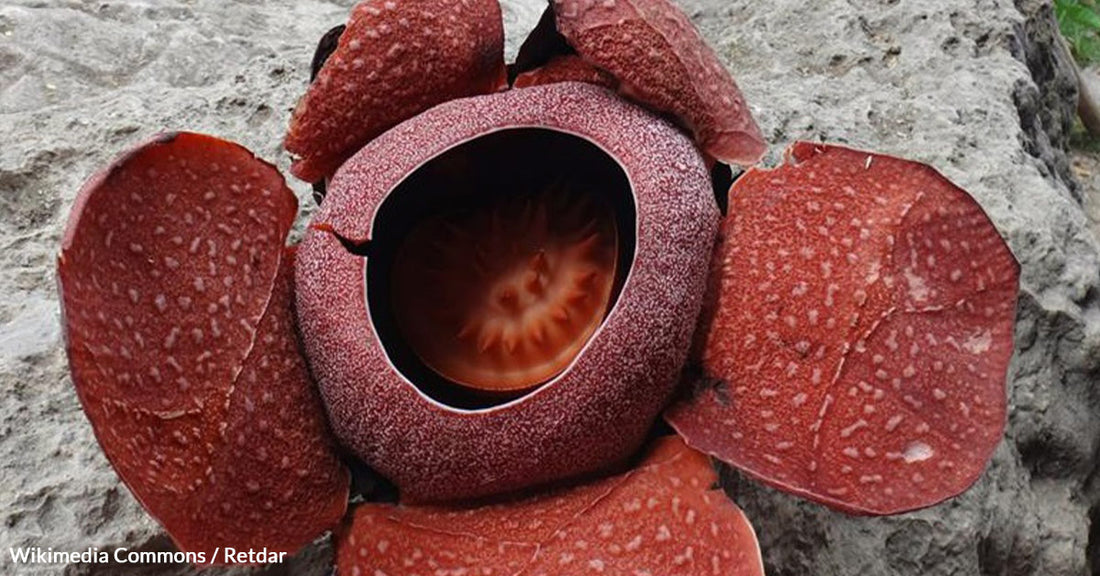7th Annual Holiday Toy & Book Event Help make the holidays brighter this year!
The Corpse Flower's Battle for Survival: A Stinky Crisis
Matthew Russell
The world is home to countless remarkable and enchanting plant species, each with its unique beauty and significance. Among them, the Rafflesia, often dubbed the corpse flower, stands out for its parasitic nature and the unmistakable scent of decaying flesh it emits.
This intriguing botanical wonder has captured the imaginations of scientists and nature enthusiasts for centuries. However, recent warnings from scientists are painting a bleak picture for the future of the corpse flower, reports the University of Oxford, as it teeters on the brink of extinction.
 Photo: Wikimedia Commons / Adiprima13, License: CC BY-SA 4.0 DEED
Photo: Wikimedia Commons / Adiprima13, License: CC BY-SA 4.0 DEEDThis parasitic plant is found in Southeast Asia, including Malaysia, Indonesia, and the Philippines.
The Mysterious World of Rafflesia
The genus Rafflesia, which includes approximately 42 known species of corpse flowers, remains shrouded in mystery. According to National Geographic, these parasitic plants have no leaves, stems, or roots and do not engage in photosynthesis. Instead, they have evolved an ingenious strategy to survive in the dense tropical jungles of Southeast Asia, including Brunei, Indonesia, Malaysia, the Philippines, and Thailand.
Rafflesia's existence revolves around its entwined relationship with tropical jungle vines. Using long filaments reminiscent of fungal cells, the plant extracts essential nutrients and water from these vines throughout its life cycle, Quanta Magazine reports.
For most of its existence, Rafflesia remains hidden within the host vine, an enigma to botanists and observers alike. However, it makes a dramatic entrance into the world when it produces a cabbage-like bud that eventually unfurls into a massive rubbery flower.
 Photo: Wikimedia Commons / Retdar, License: CC BY-SA 4.0 DEED
Photo: Wikimedia Commons / Retdar, License: CC BY-SA 4.0 DEEDRafflesia is a genus of parasitic flowering plants.
The Stench of Survival
One of the most infamous characteristics of the corpse flower is its pungent odor, akin to rotting meat. This malodorous emission serves a vital purpose: attracting flesh-eating flies that aid in pollination. The Rafflesia's ability to mimic the scent of decaying flesh with uncanny accuracy has long fascinated scientists and adventurers alike.
A Dire Warning of Extinction
Despite its remarkable adaptations and the allure of its putrid scent, the Rafflesia now faces an existential crisis. The destruction of its forest habitats in Southeast Asia threatens the survival of all 42 known species of the genus. A study, published in the journal Plants, People, Planet, delivered a stark warning – 25 of these species are classified as critically endangered, with 15 more labeled as endangered.
The alarming reality is that over two-thirds of these species receive no protection under current conservation strategies, Wired reports. This urgent situation has prompted scientists and environmentalists to sound the alarm bells. As the first global assessment of the threats looming over these unique plants, the study reveals a stark disparity between efforts to conserve plants and those dedicated to protecting animals.
 Photo: Wikimedia Commons / N00bz77, License: CC BY-SA 4.0 DEED
Photo: Wikimedia Commons / N00bz77, License: CC BY-SA 4.0 DEEDRafflesia plants are known for their enormous and foul-smelling flowers.
An Urgent Plea for Action
Chris Thorogood, an author of the study and a researcher at the University of Oxford Botanic Garden, emphasizes the need for immediate and coordinated action. He underscores that the world's most extraordinary flowers, including the iconic corpse flower, are on the verge of extinction and desperately require a comprehensive approach to preservation.
In their largely concealed life cycle, Rafflesia flowers remain elusive and poorly understood. It is believed that many populations consist of only a few hundred individuals. Shockingly, recent observations suggest that some taxa are disappearing before scientists even have the opportunity to document their existence.
Currently, only one Rafflesia species, Rafflesia magnifica, is listed as critically endangered by the International Union for the Conservation of Nature (IUCN). However, researchers are advocating for all species to receive this designation on the IUCN red list of threatened species, providing them with the crucial recognition and protection they deserve.

